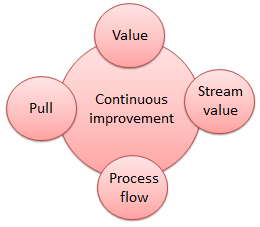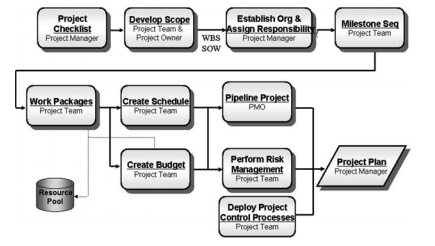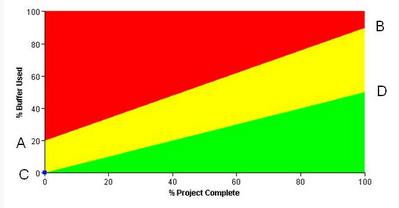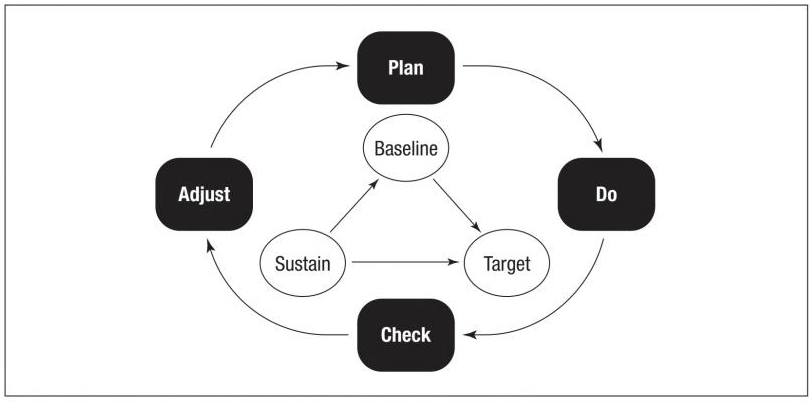Lean Project Management
Developed by Laura Ramos Sancho
Many companies fully or partially live in a project world, although most of them do not act as project-driven companies. Competition in industry increasingly makes more important the desire of optimizing what leads to provide our customers better service or product, within the time and cost agreed, and to the extent expected by them. Lean Project Management (LPM) seeks precisely that goal.
The purpose of this article is to explain how the Lean principles can be applied to make project management more efficient. Lean Project Management guide organizations toward a model of high productivity management at all stages of a project. The procedure used to analyze this issue throughout the article is the following. First, the background is provided since LPM arises as an application of the Lean manufacturing philosophy to Project Management. Also the general current situation of projects is pointed out in order to clarify that there is a necessary room of improvement. Second, the objectives and principles of LPM are defined. By recommending tools and techniques in all stages of a project process it is shown how to manage projects in a Lean way. The idea of the article is not to explain a specific LPM tool, but to provide a general framework of how to manage a project based on this philosophy. Special emphasis has been made in the controlling and monitoring step as it affects the rest of the project process and it is the most crucial step from a Lean perspective. For this reason more attention is given to the idea of continuous improvement and kaizen. Finally, a final discussion summarizes pros and cons of LPM. A collection of books and papers will support these ideas throughout the article.
Contents |
Background
History
Kiichiro Toyoda, Taiichi Ohno, and others at Toyota are the developers of the Toyota Production System (TPS) in the 1930s. This system shifted the focus of the manufacturing systems from individual machines and their utilization, to the flow of the product through the total process. Lean manufacturing is a management philosophy derived mostly from the TPS and Lean principles are derived from the Japanese manufacturing industry. The philosophy has identified as “lean” only in the 1990s and the term was used first by John Krafcit who described the thought process of lean in the book “The Machine That Changed the World”, co-authored by James P. Womack, Daniel T. Jones, and Daniel Roos. Lean implementation is focused on getting the right things to the right place at the right time in the right quality to achieve perfect work flow, while minimizing waste and being flexible.
Current status
Toyota has been the leading lean exemplar in the world and stands as the strongest proof of the power of lean enterprise. This continued success has over the past two decades created an enormous demand for greater knowledge about this management philosophy. Nowadays, there are hundreds of books and articles about lean thinking and there is an increasingly trend to spread the lean principles beyond manufacturing to other sectors (construction, services, logistics, healthcare…). Also lean thinking is beginning to take root among project managers and LPM is the application of Lean manufacturing to Project Management to improve quality and increase efficiency in projects. Firms are operating in fast-changing and highly competitive markets in which the quick adjustment to dynamic environments is essential, project managers increasingly work to improve quality, flexibility and customer response time using principles of Lean thinking [1].
According to several studies from the Project Management Institute (PMI) and others that look into the success/failure rates of projects, only 40% of projects met schedule, budget and quality goals. The rest were aborted or completed unsuccessfully. This means that more than one out to three projects fails. Also, it seems to be evident that the longer the project and the team size, the harder is the failure. The studies reveal that the main causes for projects failing are breakdown in communications, a lack of planning and poor quality control. As a consequence, the root cause for project failure can usually be tracked back to a lack of proper Project Management. Therefore there is a room of improvement in project processes and this is the goal of LPM philosophy.
Principles of LPM
Lean Project Management uses the five main principles from Lean manufacturing into a Project Management context to focus on delivering more value with less waste and reduced time in a project context. They represent essential conditions to achieve both market acceptance and operational excellence [2].
- Principle 1: Specify the value of each project desired by the customer.
- Principle 2: Identify the value stream for each project.
- Principle 3: Make the project flow continuously without interruptions.
- Principle 4: Introduce the customer pull from the project team between all continuous flow steps.
- Principle 5: Continuously pursue perfection.
In figure 1 is clearly depicted how the continuous improvement principle has to be taken into account when addressing the other principles. In addition, LPM establishes three important statements:
- It is not necessary to finish each task on time to finish a project on time.
- Starting a project sooner does not mean it will finish sooner.
- Adding buffers (protection spaces) reduces project time and cost.
A principle that underlies LPM is that any project worth doing is worth doing fast [1] . As a result, Lean Project Management helps projects run smoother and it is the quickest way to shorten project duration, reduce quality defects and boost productivity levels.
How to manage projects in a Lean way
Based on the principles of LPM, it is explained how to manage a project in a Lean way. Some specific Lean tools and techniques that can be applied to projects are proposed through the project process. Project Management can be highly complex. For this reason, the analysis is done in a sequence of steps which need to be completed to accomplish projects. In the "traditional approach" [3] processes are grouped in five development phases:1. Initiating Process
2. Planning Process
3. Executing Process
4. Closing Process
5. Monitoring and Controlling Processes
The groups overlap, and the last group applies to all of the processes [4] (see Figure 2). It is relevant to consider that projects and Project Management processes vary from industry to industry; however, these five steps of the delivery model are more traditional elements and can be applied to all kinds of projects. Even if the company is not directly project related, there is always an overarching goal to benefit the organization by means of projects; typically offering a product, changing a process or solving a problem.
Initiating Process
Many organizations start projects without considering whether they can actually complete them [5]. With LPM, the initiation process is key as it will prevent mistakes later. At the first stage, it is analyzed how companies select projects and assign the tasks of the projects, also if they have all resources they need to get the project done.
- Evaluation, selection and prioritization of projects
Following Principle 1 and the philosophy of only keeping activities and projects which add value desired by the customer, the first decision before starting any project is prioritize the present portfolio. There is no sense to squander time and resources doing work that the project’s customer is not willing to pay for. Evaluation, selection and prioritization of projects are a required practice to implement Lean thinking, the reason is simple: it is less costly to stop a project before it has been started.
Several methods exist for the selection of projects. The most common are quantitative methods, qualitative methods and hybrids methods, but sometimes more than one method is used (Project Evaluation and Selection for the Formation of the Optimal Portfolio). In choosing which projects to fund, the decision maker must have some concrete objectives in mind; in this case the main objective is to maximize value creation for the customer. A common, simple and efficient way that can help to come to a conclusion is the rating of all the projects according to criteria that lead to the main goal of the company. These criteria are previously weighed based on whether more or less provide customer value. Of course this is a simplification of reality and a combination of required internal resources and externalities which affect the project execution should be considered in the analysis. Customers (and in general stakeholders) must clearly define their expectations of the project and at this point, this is a good method to know the goals of the customer and to define the scope of the project.
- Leading People
Some considerations for project leadership must be taken into account in the first stage of the project process. Leading all of the people with an interest in the project bring to the project success. First of all, the selection of a capable Project Manager has a considerable influence on the success of a project [6]. This person controls the project value stream, and based on the Principle 3 of LPM is in charge of making the project flow continuous and without interruptions. Related to this, the Project Manager must also ensure smooth handoffs to maintain the flow of work. If the work is extended to deliver Lean projects, the Project Manager will spend more and more time and effort working with other Project Leaders to coordinate and control the cross-project functions. Interruptions occur when there is a task change, especially if the change involves a cross-project function [7]. It is important to understand that the focus should be on when hand-offs between groups occurring; every time an employee moves from one task to another, it causes errors and delays. Moreover, the Project Manager needs to understand and get involved in the Lean philosophy. Taking into account Principle 1, this person is primary responsible to ensure that projects achieve client satisfaction. A project leader able to keep stakeholders actively supporting project success throughout project execution is key.
The next pillar of a good Lean project is the Team since most of the time the project team is newly formed. Team building is complicated as to implement Lean thinking it is necessary people willing to learn new ways of working. The appointment of unsuitable staff will result in a loss of time and money which go against the LPM principles. Nevertheless, once the team is selected it is also crucial to clarify the goal and see if all members of the group are more or less in the same direction. One of the best ways to do this is to get them to work on the Project Charter [7], developing the project vision and providing a goal that they all share in common. In this way, the team members will know in the initiation phase how they are going to work together.
Planning Process
This step considers the elaboration of an effective Project Plan which provides all project stakeholders the roadmap for projects. A Project Plan is the primary tool to guide projects to success [7]. It provides the project schedule and control to it. Principle 2 will be the focus of the planning step since companies need to have a breakdown structure of their projects that details each task and who are going to do it in order to proceed as LPM states. An additional point of LPM is the need to ensure the flow of all projects. Thus, the value stream for each project is identified in this step as Principle 2 points out. Although a project schedule is an essential part of the Project Plan, it is not the only one, it also provides all that project stakeholders need to facilitate communication between them and succeed on the project (Principle 4). The Project Plan provides a flow of the process to authorize and control work, and to report progress on the project (an example is provided in figure 3). It provides a project task network with the following targets [7]:
- Define project delivery date
- Determine sequence of activities necessary to create all project deliverables
- Estimate project resources
- Enable resource scheduling
- Schedule material delivery
- Determine material order schedules
- Provide the baseline for project performance measurement
All those purposes fit with Lean thinking and support its principles.
After the elaboration of a reasonable schedule, the focus should turn to the reduction of waste. Looking at each worker contribution to the project and creating a list of prioritized tasks that each person needs to accomplish help to make the project flow smoother (Principle 3). Since projects involve multiple employees contributing to the project at different times, it is recommended the use of a scheduling software to build, status and report on the project. By means of a computerized system it is easier to record the start and completion date of each task and automatically generate a daily updated list of priorities. Some examples of commercial scheduling software which are already being implemented in industry can be seen in the links bellow. Also the video on the right side exemplifies clearly the idea.
Executing Process
From a Lean point of view, the execution of projects reveal the Lean principle of Pull to cause projects to flow from start to finish with minimal generation of waste (Principle 4). A comparison with Lean production is clear; hand-offs going through work cell to work cell can be seen as hand-offs in LPM going from one task to another.
LPM uses buffer management as a visual control tool during project execution. Implementing Pull and enhanced flow for projects requires answering three questions [7]:
- Which task do I work on next?
Tracking the real-time status is a LPM requirement, in this way it is important to state not only when the tasks start and finish, also the remaining duration for the task in-progress. It is common to update the status whenever a task starts or finish and additionally once a week. Currently, software exist which updates tasks using remaining duration and also prioritizes tasks to be worked on. Tasks causing significant project buffer use should get the highest priority. By doing this, tasks are completed in the minimum possible time and resources are focus on one project task at a time.
- When are you going to be done?
A simple method used by LPM to track schedule performance of a project is called “The Fever Chart”, this tool implements the Lean idea of visual control for projects. It follows the principle that the amount of project buffer penetration provides the signal to take action to recover buffer. As shown in figure 4, three areas of different colors form the visual graphic of the Fever Chart. Projects that are in the green region are going well, projects in the yellow region need the development of plans to recover buffer and projects in the red region require management attention and the implementation of recovery plans in order to finish the project on time. Note that projects with buffer penetration less than 100% may still be on track to complete on time [7]. Project Managers are the responsible of monitoring the Project Buffer at the appropriate time intervals for the project, usually daily but at least weekly. They can use also plotted trends of buffer. This process provides a unique anticipatory project management tool with clear decision criteria. Buffer reporting relies on realistic estimates of how many days remain to complete a task, giving project managers better insight to the performance of projects.
- How much is going to cost?
When the cost of a project is important, a cost buffer should be used in the same way (using the same graphics as above). In this case, the cost buffer penetration is the percentage of the cost buffer consumed. It has to be considered the cost variation of each of the project cost elements. The purpose is to compare or control the actual cost with the cost of the project because the actual cost is influenced by the schedule. Using the cost buffer is a way of combining conventional project management methods with LPM.
Monitoring and Controlling Processes
The controlling and monitoring step is applied to all the project process and automatically leads to the Principle 5 of LPM; continuously pursue perfection or in other words continuous improvement. This approach states that the project team should never be satisfied with the status quo and always have to look for ways to make things better. One of the Lean manufacturing approaches to achieve the continuous improvement philosophy is the kaizen initiative. Kaizen is a Japanese word which means “good change”. When Japanese people started using kaizen mindset, their companies were four times more productive and obtained quality that was 12 times better than that of their western counterparts [8]. Soon, several tools and techniques were defined in order to support this improvement process. The central tenant of kaizen is the focus on generating and promoting positive short-term results and quickly analyses the small, manageable components of a problem. Later, the rapid implementation of a solution with ongoing, real-time reassessment is applied.
Kaizen is a lifetime path of searching, reflecting, learning, and improving. It is used to make small, incremental improvements that accumulate into significant results. While this methodology has been used mainly in manufacturing operations, it is focused on helping individuals and small teams become as efficient and effective as possible at the job they do. For this reason can be applied to Project Management and the procedure applied to LPM is as follows:
The first step is the identification of the process steps, decision points and roles in order to detect if there are steps in the process which do not add value to the customer (Principle 1). Any step that does not add value should be eliminated. Now that areas of improvement have been detected, only the process causing the most pain is addressed. The procedure then is repeated to identify the next improvement. The key is to look at those activities that are repeated throughout the project process (weekly meetings, status reports, or customer reviews) and find small, incremental improvements. [9].
This is a specific case in which the PDCA Cycle is applied to LPM. The PDCA (Plan-Do-Check-Act) Cycle is a more general and popular Project Management tool that ensure the continuous improvement of processes. The four phases of the PDCA Cycle are represented in figure 5 and involve:
- Plan: Identification and analysis of the problem.
- Do: Developing and testing of the solution.
- Check: Measurement of the solution.
- Act: Implementation of the solution.
A lot of iterations of the “Do” and “Check” phases can take place.
The controlling and monitoring step of a project can be analogous to the PDCA cycle since it refers to the other steps of the process and evaluates constantly the activities that take place during the overall project process.
Closing Process
Project closure includes closing all of the project facilities, administrative closure and ensuring all project stakeholders have moved on to their next project or task. There is no much to say about the closing process from a Lean point of view. At this point, all processes need to be documented. It is important to document each of the previous steps; writing down what has been done ensure repeatability and the chances of doing good things that have been done good before increase or even will be done faster. Emphasizing the concept of continuous improvement, it is easier to find the cause of a mistake that has been documented and consequently action will be taken with greater success. The project should end with the beginning in mind [7], by bringing all stakeholders back together to collect the intellectual property developed during the project because it might help for the next ones.
Discussion
Since projects are becoming increasingly complex and uncertain, interaction between activities and resources is growing in ways not considered by traditional methods of Project Management. Nowadays, managers need more agile project management methods that are able to recognize and deal with uncertainty and to produce the expected results. LPM appears as the most convenient approach capable to deal with complexity and uncertainty.
It can be concluded from the analysis done throughout the article, that LPM philosophy would become an important part of the companies’ culture; they would see the long-term benefits of applying LPM tools and techniques. It is proved that LPM would give them a considerable competitive advantage. As the Project Management Institute states, when implemented correctly, LPM increases productivity on average 100 percent, reduces project duration an average of 30 percent, and reduces quality defects an average of 50 percent.
Nevertheless, despite all the benefits LPM provides to a company, it is not always recommended to use this approach into a project; traditional project management has proved to be successful for simple and certain projects, where the problems that arise can be solved without difficulty. Therefore, LPM is appropriate for complex and uncertain projects, where the management of the workflow, and the perspective focused on customer’s value are the main characteristics. Thus, to decide which method should be applied, it results necessary to evaluate the uncertainty and risks of each project before the beginning, but this falls outside the scope of the present article.
Finally, it is important to notice that attempting change in an organization can be difficult. Big changes are met with fear, doubt, laziness and other barriers. Big changes provide slower results, and if there are not immediate results there are more probabilities of abandoning the change. In that sense LPM is a good method because it takes small steps that can be measured and solidified providing at the end meaningful results. Due to this reason, LPM has a high probability of success in the future of a lot of organizations.
See also
The article is linked to other relevant pages in the APPPM wiki and they are relevant for further information on the topic:
References
- ↑ 1.0 1.1 Rosemary R. Fullerton, Frances A. Kennedy, Sally K. Widener, (2014) ‘Lean manufacturing and firm performance: The incremental contribution of lean management accounting practices’, Journal of Operations Management, Volume 32, Issues 7-8, November 2014, pages 414-428.
- ↑ Ronald Mascitelli, (2002) ‘Building a Project-Driven Enterprise: How to Slash Waste and Boost Profits Though Lean Project Management Institute'.
- ↑ Wysocki, Robert K (Robert k), ‘Effective Project Management: Traditional, Adaptive, Estreme'.
- ↑ Booksurge Publishing (2006), 'Project Management Body of Knowledge',PMBOK Guide, Fourth Edition, December 2008'.
- ↑ Project Management Institute, (2006) ‘The Standard for Porfolio Managements.’
- ↑ H. Mikkelsen, E. Folmann (1983),‘Selection of managers for international projects’, International Journal of Project Management, Vol1, No4.
- ↑ 7.0 7.1 7.2 7.3 7.4 7.5 7.6 Lawrence P, Leach, PMP, (2005) ‘Lean Project Management: Eight Principles for Success.’ Combining Critical Chain Project Management [CCPM] and Lean tools to accelerate project results.
- ↑ Ángel Medina, (2014) 'Agile Kaizen. Managing Continuous Improvement Far Beyond Retrospectives', Springer Berlin Heidelberg
- ↑ Bob Tarne, PMP, CSM, CSSBB, (2009) 'How Continuous Improvement Can Help Your Project', Project Management Institute
Further reading
- Ángel Medinilla, (2014). 'Agile Kaizen: Managing Continuous Improvement Far Beyond Retrospectives'. Springer Berlin Heidelberg.
- Graves, Samuel B., Ringuest, Jeffrey L. (2003). 'Models & Methods for Project Selection'. Concepts from Management Science, Finance and Information Technology. International Series in Operations Research & Management Science, Vol 58.




